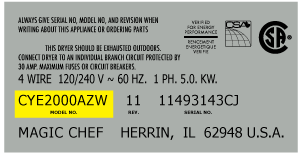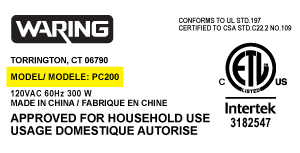GU23 Whirlpool Dishwasher - Instructions
Keep searches simple. Use keywords, e.g. "leaking", "pump", "broken" or "fit".
Replaced Hinge Link
Pulled dishwasher from under counter, attached link to spring, hooked spring back into frame/chassis, threaded link through pulleys, attached other end of link onto door, reinstalled dishwasher under counter. All's well. Note-I purchased an extra link anticipating that the other one will fail. They're cheap enough.
Parts Used:
-
Scott from Fort Lauderdale, FL
-
Difficulty Level:Easy
-
Total Repair Time:Less than 15 mins
-
Tools:Screw drivers
633 of 678 people
found this instruction helpful.
Was this instruction helpful to you?
Thank you for voting!
dishwasher not draining after wash cycle
Caviat: The actual repair is less than 15 minutes, but I spent a lot of time playing with it before I figured out it was that easy and fast. You don't need to remove the dishwasher from the counter to do this. And it will probably help to look at the new part closely so you can understand where the retainer clip is to press it and release the old pump.
First remove the water from the dishwasher pan that would not drain with a wet/dry vac. Otherwise the water will all drain on the floor when you remove the pump. Then remove the two screws on the kickplate on the front of the unit below the door. Remove the kickplate/maintainence access cover. The drain pump is on the right about 8 inches in. Using two hands you grasp the drain pump with your right hand and use the left hand to push the retaining clip down. Then the drain pump will rotate 1/4 turn counterclockwise and can be removed without pulling the dishwasher out. There is likely to be some water leak out that was traped in the pump housing that you can not reach with the vac. Disconnect the wire. Connect the wire to the new pump, put it in place and 1/4 turn clockwise to install it. Replace the kickplate and you're done.
First remove the water from the dishwasher pan that would not drain with a wet/dry vac. Otherwise the water will all drain on the floor when you remove the pump. Then remove the two screws on the kickplate on the front of the unit below the door. Remove the kickplate/maintainence access cover. The drain pump is on the right about 8 inches in. Using two hands you grasp the drain pump with your right hand and use the left hand to push the retaining clip down. Then the drain pump will rotate 1/4 turn counterclockwise and can be removed without pulling the dishwasher out. There is likely to be some water leak out that was traped in the pump housing that you can not reach with the vac. Disconnect the wire. Connect the wire to the new pump, put it in place and 1/4 turn clockwise to install it. Replace the kickplate and you're done.
Parts Used:
-
Andrew from Alexandria, VA
-
Difficulty Level:Easy
-
Total Repair Time:Less than 15 mins
-
Tools:Screw drivers
486 of 549 people
found this instruction helpful.
Was this instruction helpful to you?
Thank you for voting!
Heater element broken.
Step 1: Remove the screws in the bottom of the countertop.
Step 2: Remove the screws holding the bottom kickplate.
Step 3: Loosen leveling legs.
Step 4: Pull dishwasher out of hole.
Step 5: Unlplug dishwasher.
Step 6: Disconnect wires from bottom of element in back.
Step 7: Remove plastic nuts holding element in place.
Step 8: Remove element.
Step 9: Reverse Steps 1-7.
Step 10: Drink beer.
Step 2: Remove the screws holding the bottom kickplate.
Step 3: Loosen leveling legs.
Step 4: Pull dishwasher out of hole.
Step 5: Unlplug dishwasher.
Step 6: Disconnect wires from bottom of element in back.
Step 7: Remove plastic nuts holding element in place.
Step 8: Remove element.
Step 9: Reverse Steps 1-7.
Step 10: Drink beer.
Parts Used:
-
Dennis from Sedro Woolley, WA
-
Difficulty Level:Really Easy
-
Total Repair Time:Less than 15 mins
-
Tools:Screw drivers, Wrench set
229 of 265 people
found this instruction helpful.
Was this instruction helpful to you?
Thank you for voting!
Loud grinding noise from water pump
Rather than remove the pump assembly - as an earlier post had done - I pulled the entire dishwasher out and laid it down on the floor. This allowed easy, direct access to the motor (that was the hard, messy part). From this point it was easy. Unplug the wiring, remove the retaining bolt, rotate the motor off the mounting brackets and pull it out. Then put the new one in. That was the easy part (about 15 minutes). The entire job took 2-and-a-half hours, most of which was taken in disconnecting, cleaning up and reconnecting the dishwasher. It's much quieter now.
Parts Used:
-
Steve from Inver Grove Heights, MN
-
Difficulty Level:A Bit Difficult
-
Total Repair Time:More than 2 hours
-
Tools:Nutdriver, Pliers, Screw drivers, Wrench (Adjustable)
224 of 254 people
found this instruction helpful.
Was this instruction helpful to you?
Thank you for voting!
would not turn on
I did a search on the website and read the instructions for trouble shooting. I took the inside door off by taking the screws out. I pulled the part and tested it and found it did not in fact have no ampage. I then ordered the part on line. It came in two days, I plugged it in, put the door back together and the total time was about 15-20 minutes. Easy, simple, great instructions and the entire thing only costed me the part itself. It's working great now! And I've never worked on appliances before.
Parts Used:
-
Douglas from Dallas, GA
-
Difficulty Level:Really Easy
-
Total Repair Time:Less than 15 mins
-
Tools:Screw drivers
201 of 232 people
found this instruction helpful.
Was this instruction helpful to you?
Thank you for voting!
water leaking out of bottom of machine
removes the 1 screw that held the old one in and removed the water lines the supply line with a adjustable wrench and the internal line had a hose clamp on it then i just went in reverse...
Parts Used:
-
MICHELLE from EDEN VALLEY, MN
-
Difficulty Level:Easy
-
Total Repair Time:Less than 15 mins
-
Tools:Nutdriver, Pliers, Wrench (Adjustable), Wrench set
193 of 215 people
found this instruction helpful.
Was this instruction helpful to you?
Thank you for voting!
dispenser door was not closing
1. Remove torx screws around outer edge of inside of door.
2. Separate outer door panel from inner door panel.
3. Locate dispenser, and remove 6 hex nuts and 2 wires for solenoid.
4. Insert new dispenser and re-insert hex nuts.
5. Reinsert torx screws.
2. Separate outer door panel from inner door panel.
3. Locate dispenser, and remove 6 hex nuts and 2 wires for solenoid.
4. Insert new dispenser and re-insert hex nuts.
5. Reinsert torx screws.
Parts Used:
-
Ed from Fanwood, NJ
-
Difficulty Level:Easy
-
Total Repair Time:30 - 60 mins
-
Tools:Nutdriver
166 of 184 people
found this instruction helpful.
Was this instruction helpful to you?
Thank you for voting!
Dishwasher motor - making a very loud grinding noise
I went on the internet and found a pdf file with the Kitchenaid dishwasher repair manual for my model. One of the hardest parts of the job was convincing myself that I could do the job. When you're young, you just go out and buy a new dishwasher and tell yourself, "it's only money, we'll make more." When you're over 50, you tell yourself, "I can fix this. It will mean I get to retire a week sooner if I don't spend another $700 for a new dishwasher."
In hindsight, I could have done this job (replace the motor) in about 30 minutes. 1) Turn off electrical breaker in basement. 2) slide out dishwasher. 3) disconnect water supply. 4) use old towels to soak up any water still in the tub. 5) turn dishwasher on it's side. 6) unhook the wire harness plug from the motor, squeeze with fingers to unhook. 7) unbolt motor, 1 bolt. 8) turn motor counterclockwise, 1/4 turn. 9) pull motor out from sump, requires some force. 10) install new motor, but use some rinse aid to lubricate the rubber seal on it. Instead I did things the hard way and took the whole darn machine apart!!! See my story below.
I was surprised at how simple the design was and how few parts there really were inside the dishwasher. I found the pdf repair manual very useful, and I also found some repair videos on line. One thing they may or may not tell you - clean the parts well and lubricate the gaskets with some 'rinse aid' liquid when you put the machine back together. Also, it might help you to take a few pictures with a digital camera before you take things apart - that might help you remember how things go back together. Take close up pictures and use a treble light to illuminate the area when you're taking a picture.
The new motor was the ticket to fixing the loud noise. I was worried because the part cost $150. Before I ordered a new motor, I hooked up the old motor to electricity on my work bench and was able to recreate the really loud noise - so I was pretty sure that the new motor would eliminate the problem. It was very easy to install the new motor, only one bolt holds it in place. I did need to disassemble several parts to get to it though. Have no fear. One thing I did was mark the electric leads that went to the small pump with red and black sharpie markers so I could easily see which terminals to plug them back onto.
After reassembling the whole dishwasher with a new motor and testing the dishwasher for leaks by pouring a couple pitchers of water into it - I put the beast back under the counter (hooking it back up to the water supply line, the drain pipe to the garbage disposal and finally the electric supply). Then I ran it and water gushed out the bottom.
This whole job should have been easy, but things never go easy for me. Maybe if I would have lubricated the old sump gasket with rinse aid it would have sealed properly when I reinstalled it. Maybe if I would have cleaned the old sump gasket and the bottom of the tub really thoroughly things would have sealed right. But I didn't - so it leaked. I went ahead and bought a new sump gasket ($30 and had a few more days of waiting and self-doubt and having the dishwasher broken down). One the gasket came, I went through the entire uninstall, disassembly, reassembly and reinstall process AGAIN!!! This time with the new clean sump gasket and thoroughly cleaned surfaces. I also lubricated the gasket with rinse aid before installation. NO LEAKS! Job finished. Lessons learned. Doing it the first time was pretty tough though. Good luck! Get a helper for moral support and picture taking!
In hindsight, I could have done this job (replace the motor) in about 30 minutes. 1) Turn off electrical breaker in basement. 2) slide out dishwasher. 3) disconnect water supply. 4) use old towels to soak up any water still in the tub. 5) turn dishwasher on it's side. 6) unhook the wire harness plug from the motor, squeeze with fingers to unhook. 7) unbolt motor, 1 bolt. 8) turn motor counterclockwise, 1/4 turn. 9) pull motor out from sump, requires some force. 10) install new motor, but use some rinse aid to lubricate the rubber seal on it. Instead I did things the hard way and took the whole darn machine apart!!! See my story below.
I was surprised at how simple the design was and how few parts there really were inside the dishwasher. I found the pdf repair manual very useful, and I also found some repair videos on line. One thing they may or may not tell you - clean the parts well and lubricate the gaskets with some 'rinse aid' liquid when you put the machine back together. Also, it might help you to take a few pictures with a digital camera before you take things apart - that might help you remember how things go back together. Take close up pictures and use a treble light to illuminate the area when you're taking a picture.
The new motor was the ticket to fixing the loud noise. I was worried because the part cost $150. Before I ordered a new motor, I hooked up the old motor to electricity on my work bench and was able to recreate the really loud noise - so I was pretty sure that the new motor would eliminate the problem. It was very easy to install the new motor, only one bolt holds it in place. I did need to disassemble several parts to get to it though. Have no fear. One thing I did was mark the electric leads that went to the small pump with red and black sharpie markers so I could easily see which terminals to plug them back onto.
After reassembling the whole dishwasher with a new motor and testing the dishwasher for leaks by pouring a couple pitchers of water into it - I put the beast back under the counter (hooking it back up to the water supply line, the drain pipe to the garbage disposal and finally the electric supply). Then I ran it and water gushed out the bottom.
This whole job should have been easy, but things never go easy for me. Maybe if I would have lubricated the old sump gasket with rinse aid it would have sealed properly when I reinstalled it. Maybe if I would have cleaned the old sump gasket and the bottom of the tub really thoroughly things would have sealed right. But I didn't - so it leaked. I went ahead and bought a new sump gasket ($30 and had a few more days of waiting and self-doubt and having the dishwasher broken down). One the gasket came, I went through the entire uninstall, disassembly, reassembly and reinstall process AGAIN!!! This time with the new clean sump gasket and thoroughly cleaned surfaces. I also lubricated the gasket with rinse aid before installation. NO LEAKS! Job finished. Lessons learned. Doing it the first time was pretty tough though. Good luck! Get a helper for moral support and picture taking!
Parts Used:
-
Michael from St. Louis, MO
-
Difficulty Level:A Bit Difficult
-
Total Repair Time:More than 2 hours
-
Tools:Nutdriver, Pliers, Screw drivers
149 of 154 people
found this instruction helpful.
Was this instruction helpful to you?
Thank you for voting!
The door gasket stuck to the door a pulled out of place after every use
Worked the new gasket into the groove with a smooth screwdriver and my fingers. No leaks and it stays in place. Parts Select had the right part and I got it fast
Parts Used:
-
Penny from Manchester, MI
-
Difficulty Level:Really Easy
-
Total Repair Time:15 - 30 mins
-
Tools:Screw drivers
159 of 191 people
found this instruction helpful.
Was this instruction helpful to you?
Thank you for voting!
Door spring link broken
1. Open the dishwasher and remove the two plastic grommets about halfway down on either side of the opening. Then remove the two screws under the grommets.
2. Remove the kick plate under the door. May have to lower unit by turning the feet using the adjustable wrench.
3. Make sure you have enough slack in the water input line and electrical wiring that you can pull the dishwasher out about 12 inches or more.
4. There is a spring and nylon rope link on both sides of the unit. Probably just one link is broken, but the replacement comes with two, so you can replace both or save one as a spare. Look at the good side and it should be pretty self explanatory how it attaches. I found it easiest to first thread the link around the lower pulley, then attach the link to the spring, then spring to the rear support, then the link to the door.
5. Reverse (2 to 1) to reinstall the dishwasher.
2. Remove the kick plate under the door. May have to lower unit by turning the feet using the adjustable wrench.
3. Make sure you have enough slack in the water input line and electrical wiring that you can pull the dishwasher out about 12 inches or more.
4. There is a spring and nylon rope link on both sides of the unit. Probably just one link is broken, but the replacement comes with two, so you can replace both or save one as a spare. Look at the good side and it should be pretty self explanatory how it attaches. I found it easiest to first thread the link around the lower pulley, then attach the link to the spring, then spring to the rear support, then the link to the door.
5. Reverse (2 to 1) to reinstall the dishwasher.
Parts Used:
-
Sean from Ramona, CA
-
Difficulty Level:Easy
-
Total Repair Time:15 - 30 mins
-
Tools:Screw drivers, Wrench (Adjustable)
156 of 191 people
found this instruction helpful.
Was this instruction helpful to you?
Thank you for voting!
latch on dispenser cover broke
Printed door assembly parts list and photo from KitchenAid website. (With the absence of instructions, it was a big help.) Remove door cover. You'll need a star driver bit. Remove the old dispenser. Note how the metal clamp and black cover sheet are positioned. Install the new dispenser. Insure the wiring harness is snapped in place. Replace the door cover. Not difficult; just some patience. One more hint ... be careful when taking the door cover off and you won't have to disconnect any other wiring.
Parts Used:
-
Craig from Austin, TX
-
Difficulty Level:Easy
-
Total Repair Time:30 - 60 mins
-
Tools:Nutdriver, Screw drivers, Socket set
141 of 155 people
found this instruction helpful.
Was this instruction helpful to you?
Thank you for voting!
Wanted to replace white panel with stainless steel to match other appliances.
My husband removed the existing panel by removing the retaining screws. Installed the new panel and replaced the screws. Very pleased with the new look and how easy it was.
Parts Used:
-
Sandra from McKinney, TX
-
Difficulty Level:Easy
-
Total Repair Time:Less than 15 mins
-
Tools:Screw drivers
134 of 144 people
found this instruction helpful.
Was this instruction helpful to you?
Thank you for voting!
The wheels on the upper dish rack broke
I removed the end caps on the slides with needle nose pliers, removed the old wheels and installed the new ones, then I snapped the slide end caps back on. Super responsive service from PartSelect.com Thanks!
Parts Used:
-
James from Gulfport, MS
-
Difficulty Level:Really Easy
-
Total Repair Time:Less than 15 mins
-
Tools:Pliers
132 of 144 people
found this instruction helpful.
Was this instruction helpful to you?
Thank you for voting!
The door would drop open when it was released
This was the second time I had this problem so I knew the symptoms and remedy. The tools needed were two nut drivers a ¼” and 5/16” along with a flat pry bar and Phillips screw driver. I started by removing the lower front panel by removing the two ¼” screws on either side. The lower panel will lift up and then can be removed by pulling on the bottom. There is a flat sheet metal piece behind the front panel with insulation that can be removed very easily along with the front panel. When the front panel is removed it exposes the front legs that may need to be dropped to let you lift the dishwasher over the tile (if you have ceramic tiles). The next step would be to remove any ties to the counter top if it is attached. Mine were attached by the two straps on either side with Phillips screws. After the top is free, lower the front legs by lifting the dishwasher with the flat pry bar and threading the legs up into their holders. With the legs lifted the dishwasher can be pulled out to expose the tension springs located along the sides at the very bottom. Chances are the ropes are broken off the plastic holders that fit over the door hooks.
Remove the plastic guides by removing the 5/16” nut from the middle of the lower roller. Remember to note which hole the screw is coming from this also sets the tension for how fast or slowly the door drops. Placing the nut closer to the front will drop the door slowly and toward the back will drop the door more quickly. I placed mine in the middle hole. When the plastic guides are removed attach the nylon pope to the spring and attach to the back of the dishwasher. There is a hole located on a flat piece of sheet metal the spring will attach to at the back of the dishwasher (if it is broken). Check the other side if it is still in tact. With the spring in place weave the rope around the plastic guides then pull the springs to help get the plastic end over the door hook located at the bottom of the door. Repeat this operation for the other side (kit has a both sides covered) and reinstall dishwasher in cabinet.
Steps
1) Remove front panel (1/4” nut)
2) Release Dishwasher from Cabinet
3) Lower front legs
4) Pull Dishwasher out from under Cabinet
5) Remove Rope Guide (5/16” nut)
6) Install new Rope Guide (Supplied in Kit)
7) Attach new rope to Spring and attach spring to dishwasher
8) Weave rope through rope guide
9) With door closed pull spring to relieve tension so rope can be attached to door
10) Repeat for other side (Kit has both sides)
Remove the plastic guides by removing the 5/16” nut from the middle of the lower roller. Remember to note which hole the screw is coming from this also sets the tension for how fast or slowly the door drops. Placing the nut closer to the front will drop the door slowly and toward the back will drop the door more quickly. I placed mine in the middle hole. When the plastic guides are removed attach the nylon pope to the spring and attach to the back of the dishwasher. There is a hole located on a flat piece of sheet metal the spring will attach to at the back of the dishwasher (if it is broken). Check the other side if it is still in tact. With the spring in place weave the rope around the plastic guides then pull the springs to help get the plastic end over the door hook located at the bottom of the door. Repeat this operation for the other side (kit has a both sides covered) and reinstall dishwasher in cabinet.
Steps
1) Remove front panel (1/4” nut)
2) Release Dishwasher from Cabinet
3) Lower front legs
4) Pull Dishwasher out from under Cabinet
5) Remove Rope Guide (5/16” nut)
6) Install new Rope Guide (Supplied in Kit)
7) Attach new rope to Spring and attach spring to dishwasher
8) Weave rope through rope guide
9) With door closed pull spring to relieve tension so rope can be attached to door
10) Repeat for other side (Kit has both sides)
Parts Used:
-
David from La Quinta, CA
-
Difficulty Level:Easy
-
Total Repair Time:30 - 60 mins
-
Tools:Nutdriver
124 of 140 people
found this instruction helpful.
Was this instruction helpful to you?
Thank you for voting!
Water leaking from front right corner (door) while washer running
The hardest part of this was figuring out the cause of the leak. It only leaked while the washer was running (arms spinning). I thought it might be the air intake seal at the lower part of the door-but that did not look damaged.
I cleaned off the door gasket really good and that slowed the leak - so I figured the gasket was the problem (plus changing the gasket is cheap and it was old anyway).
I pulled the old gasket off (no tools required).
I cleaned the track/slot that the gasket goes into, and the area around it from all the caked-on soap and gunk.
Cleaned off the door edge that seals with the gasket too.
I took the new gasket and folded it in half to find the middle, then started with the middle, putting it into the track (used the center door latch on the frame to know the middle on the washer).
I worked the gasket into the slot just with my fingers. I found that if I pinched the part that goes into the slot with my thumb/finger that helped get it deep into the slot without tools.
I worked around one side, slowly and carefully pushing it into the slot. Did the other side the same way - starting from the middle and working down to the end at the bottom of the washer. Checked the gasket to make sure it was all set in well.
There is an inch or so of the gasket left over at the bottom - I just bent that around the bend so it was not in the way.
I cleaned off the door gasket really good and that slowed the leak - so I figured the gasket was the problem (plus changing the gasket is cheap and it was old anyway).
I pulled the old gasket off (no tools required).
I cleaned the track/slot that the gasket goes into, and the area around it from all the caked-on soap and gunk.
Cleaned off the door edge that seals with the gasket too.
I took the new gasket and folded it in half to find the middle, then started with the middle, putting it into the track (used the center door latch on the frame to know the middle on the washer).
I worked the gasket into the slot just with my fingers. I found that if I pinched the part that goes into the slot with my thumb/finger that helped get it deep into the slot without tools.
I worked around one side, slowly and carefully pushing it into the slot. Did the other side the same way - starting from the middle and working down to the end at the bottom of the washer. Checked the gasket to make sure it was all set in well.
There is an inch or so of the gasket left over at the bottom - I just bent that around the bend so it was not in the way.
Parts Used:
-
Clifford from Centennial, CO
-
Difficulty Level:Easy
-
Total Repair Time:15 - 30 mins
95 of 99 people
found this instruction helpful.
Was this instruction helpful to you?
Thank you for voting!



































